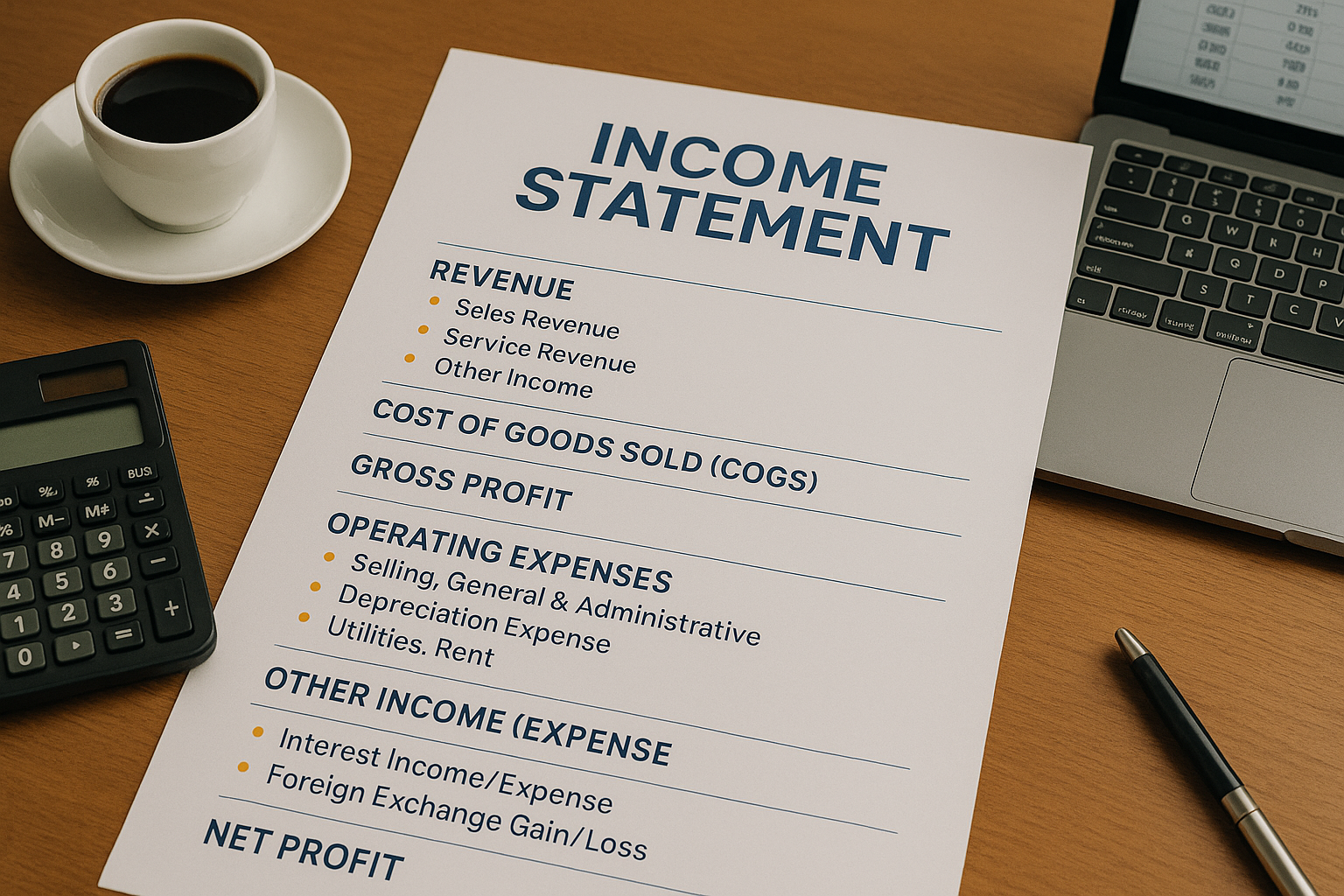In the business world, it's not enough to know your sales volume or how much you spent this month. What you really need is a financial tool that shows the complete picture of your company's financial performance over a specific period of time. This tool is known as an income statement.
An income statement is not just an accounting document; it is a mirror that reflects your company's ability to generate profits and shows whether your operations are heading in the right direction. It allows the business owner or financial manager to assess operational efficiency and make decisions based on real data.
This guide is intended for business owners, executives, and anyone seeking to understand how revenues and expenses affect net profit. We will explain the components of an income statement, clarify how it differs from other statements, and review how it can be used as a tool for analyzing and measuring financial performance.

What is an income statement?
An income statement is one of the main financial statements, also known as a “profit and loss statement.” It aims to show the results of a company's financial operations during a specific period (month, quarter, fiscal year) by comparing revenues with expenses.
The final result of the statement is either:
Net profit if revenues exceed expenses.
Net loss if expenses are higher than revenues.
The income statement is prepared on an accrual basis, which means that revenues and expenses are recorded when they are realized, not when they are collected or paid in cash.
The importance of the income statement in business management
The income statement is used by several internal and external parties for various purposes:
Business owners: to understand the business's ability to generate profits and analyze performance.
Investors: to assess the company's profitability and the viability of investing in it.
Banks and lenders: To assess creditworthiness and make financing decisions.
Tax authorities: To calculate tax liabilities.
Operational management: To make decisions regarding cost reduction or productivity improvement.
Without an income statement, management loses a key tool for monitoring the health of financial and commercial activity.
The difference between an income statement and a cash flow statement
Despite the similarity in names, each statement has a different function:
Comparison
Income statement
Cash flow statement
Accounting basis
Accrual
Cash basis
Purpose
Measure profitability
Measure liquidity
Recording revenue
When earned
When cash is received
Recording expenses
When incurred
When cash is paid
Analytical use
Profitability and operating performance
Ability to meet obligations
Conclusion: The income statement shows what the company has earned, while the cash flow statement shows what it has received.
Components of the income statement in detail
Revenue
Represents the total income generated from the sale of products or the provision of services during the financial period.
Example: A software company sold subscriptions worth $200,000 during the first quarter.
Cost of goods sold (COGS)
This includes all direct costs associated with producing goods or providing services.
Example: Software developers' salaries or the cost of raw materials.
Gross profit
Calculated using the formula:
Gross profit = Revenue – Cost of goods sold
This indicator shows the initial profitability before operating expenses are calculated.
Operating expenses
These include:
Sales and marketing expenses
Administrative and general expenses
Depreciation and amortization
Operating Income
Operating income = gross profit – operating expenses
Reflects the company's ability to generate profits from its core business.
Non-operating income and expenses
Includes:
Interest income
Gains or losses on investments
Currency differences
Net profit before tax
= Operating profit + Net non-operating income/expenses
Tax
Calculated based on local laws, subtracted to arrive at:
Net profit or loss
Net profit = Profit before tax – Taxes
This is the final indicator for measuring the success of a business.
Types of income statements: single-step vs. multi-step
Type
Description
Suitable for whom?
Single-step income statement
Revenues are collected in one line, and expenses in another line only
Small or individual projects
Multi-step statement
Distinguishes between gross profit, operating profit, and net profit
Medium and large companies
Basic equations used
Revenue = Price × Quantity
Gross profit = Revenue – Cost of sales
Operating profit = Gross profit – Operating expenses
Net profit = Profit before tax – Taxes
Practical example of a simplified income statement
Item
Value (L.S.)
Revenue
500,000
– Cost of sales
200,000
= Gross profit
300,000
– Operating expenses
100,000
= Operating profit
200,000
± Other expenses and interest
-20,000
= Profit before tax
180,000
– Taxes (20%)
36,000
= Net profit
144,000

How to prepare an income statement using accounting systems
Platforms such as Wazen offer advanced tools to automatically generate income statements by linking to billing and accounting systems.
Advantages of using Wazen:
Easy and accurate tracking of income and expenses
Automatic classification of expenses
Support for monthly, quarterly, and annual statements
Printable and exportable reports
With Wazen, you don't need to prepare statements manually, which saves time and reduces the likelihood of errors.
Common mistakes in income statement analysis
Confusing operating and non-operating expenses
Neglecting deferred or accrued income
Relying solely on net profit without considering total profit
Ignoring comparative analysis between periods
How does Wazen help you improve income statement management?
Wazen is not just an accounting platform, but an analysis tool that helps companies make smart financial decisions.
Through an easy-to-use dashboard, you can:
Track operational performance in real time
Analyze profitability trends across periods
Prepare customized reports for investors or banks
Receive alerts about financial deviations
Why do entrepreneurs prefer it?
Arabic user interface
Integration with billing, inventory, and taxes
Specialized and responsive technical support
Conclusion
An income statement is not just a financial document, but a strategic tool for every company seeking growth and sustainability. By understanding its components and analyzing its data, you can evaluate performance, identify weaknesses, and improve profitability.
If you are not yet using a system that intelligently manages your financial statements, it is time to try Wazen solutions.
Start analyzing your statements with Wazen today and watch how your decisions change for the better.
